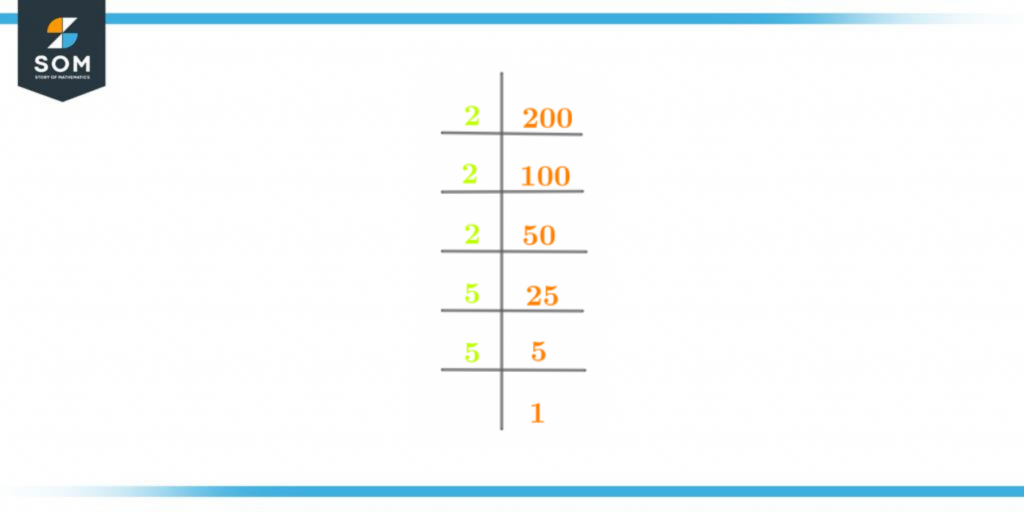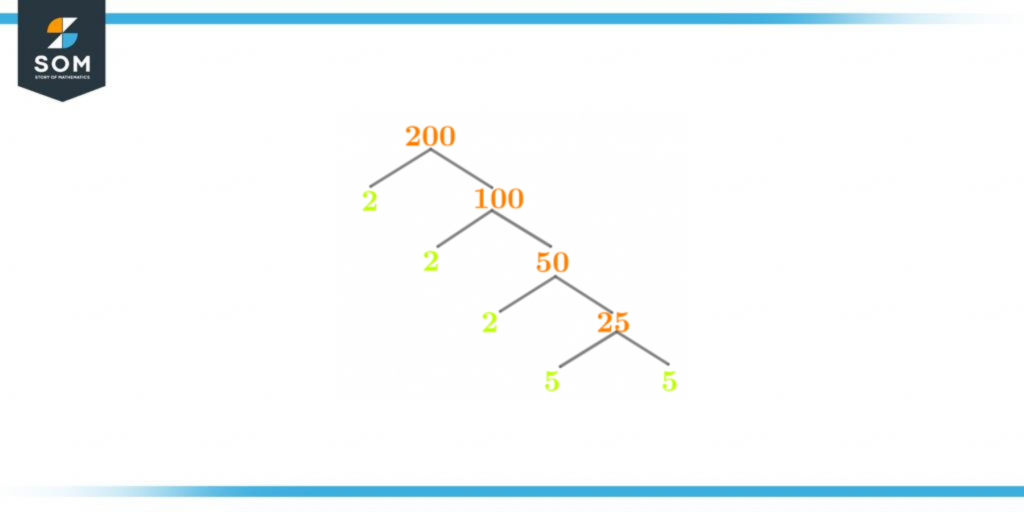JUMP TO TOPIC
Factors of 200: Prime Factorization, Methods, Tree, and Examples
The factors of 200 are the numbers that make the number 200 completely divisible when they act as the divisors for the number 200. Such numbers always produce zero as the remainder and a whole number quotient.
Figure 1 – All possible Factors of 200
What Are the Factors of 200?
The factors of 200 are the following: 1, 2, 4, 5, 8, 10, 20, 25, 40, 50, 100, and 200. These natural numbers produce a zero as remainder when 200 acts as their dividend.So in conclusion, the number 200 has a total of 12 factors which can be evenly divided into 6-factor pairs. 200 is an even number; it is a composite number with more than two factors.How To Calculate the Factors of 200?
You can calculate the factors of 200 through various mathematical methods, but the one that is the simplest and the most accurate is the division method. The division method revolves around the division operation.In the division method, the number acts as the dividend and is subjected to division with various numbers, which may be the possible factors. After the division procedure, only those numbers are capable of being called factors that produce a whole number quotient and a zero remainder.The number 200 is an even composite number, indicating that the number 200 will have more than two factors. Since it is an even number and appears to be a multiple of 5, the numbers 2 and 5 will be one of the factors of the number 200.Let’s apply the division method to the number 200.\[ \frac{200}{1} = 200 \]\[ \frac{200}{2} = 100\]\[ \frac{200}{4} = 50 \]\[ \frac{200}{5} = 40 \]\[ \frac{200}{8} = 25 \]\[ \frac{200}{10} = 20 \]\[ \frac{200}{20} = 10 \]\[ \frac{200}{25} = 8 \]\[ \frac{200}{40} = 5 \]\[ \frac{200}{50} = 4 \]\[ \frac{200}{100} = 2 \]\[ \frac{200}{200} = 1 \]Therefore, the list of all the factors of 200 is:Factors of 200 are the following: 1, 2, 4, 5, 8, 10, 20, 25, 40, 50, 100, and 200There is no restriction that the factors of a number are only supposed to be positive. The negative factors can also be stated as they are nothing but negative integers. These negative integers are the same as positive integers but have a negative sign.The negative factors for 168 are given below:Negative Factors of 168: -1, -2, -4, -5, -8, -10, -20, -25, -40, -50, -100, and -200Factors of 200 by Prime Factorization
Prime factorization is a unique division-based technique that is utilized for estimating the prime factors of a number. The prime factors of any number are all prime numbers. The prime factorization initiates with the number itself as the dividend, and the division of this dividend is carried out with the help of prime numbers. These prime numbers act as divisors.The whole number quotient they produce then again acts as the dividend, and this process is repeated until the number 1 is the only number that remains in the end. The unique aspect of prime factorization is that only prime numbers can act as divisors in every division step.The prime factorization for the number 200 is shown below:200 $\div$ 5 = 40
40 $\div$ 5 = 8
8 $\div$ 2 = 4
4 $\div$ 2 = 2
2 $\div$ 2 = 1
The mathematical expression for this prime factorization is:Prime Factorization of 200 = 5 x 5 x 2 x 2 x 2
OrPrime Factorization of 200 = 5$^{2}$ x 2$^{3}$
The prime factorization of 200 is also given in the diagram below:
Figure 2 – Prime Factorization of 200
Factor Tree of 200
The factor tree is a visual representation of the prime factorization. It is used to show the prime factors in the form of a diagram. As the name reflects, the factor tree resembles a tree-like structure.The unique aspect of the factor tree is that one of its branches will always hold prime numbers, and the end branches will always occupy prime numbers. The factor tree for the number 200 is given below:
Figure 3 – Factor Tree of 200
Factors of 200 in Pairs
The number 200 has a total of 12 factors, and these 12 factors can be arranged in the form of 6-factor pairs. A factor pair is a pair of numbers that yield the original number as the product when multiplied together.The factors of 200 can be arranged in the form of the following pairs:1 x 200 = 200
2 x 100 = 200
4 x 50 = 200
5 x 40 = 200
8 x 25 = 200
10 x 20 = 200
So, the positive factor pairs of 200 are:Factor Pairs of 200 = (1, 200), (2, 100), (4, 50), (5, 40), (8, 25), and (10, 20)As negative factors are also present for the number 200 so this means that the negative factors of 200 can also be arranged in the form of pairs. The condition of negative factor pairs is that both numbers must have a negative sign.So the negative factor pairs are:-1 x -200 = 200
-2 x -100 = 200
-4 x -50 = 200
-5 x -40 = 200
-8 x -25 = 200
-10 x -25 = 200
So the negative factor pairs of 200 are:Negative Factor Pairs of 200 = (-1, -200), (-2, -100), (-4, -50), (-5, -40), (-8, -25), and (-10, -25)Factors of 200 Solved Examples
Now that we have covered all the necessary information regarding the factors of 200, let’s move on to some solved examples to further enhance our learning regarding the factors of 200.Example 1
Separate the even and odd factors of 200 and calculate their respective averages.Solution
For solving this example, let’s first list the factors of 200. These are:Factors of 200 are the following: 1, 2, 4, 5, 8, 10, 20, 25, 40, 50, 100, and 200Now, let’s first deal with the even factors. The even factors of 200 are given below:Even Factors of 200 = 2, 4, 8, 10, 20, 40, 50, 100, and 200Calculating the average of these even factors:\[ Average = \frac{\text{Sum of even factors of 200}}{\text{Total number of even factors}} \]\[ Average = \frac{2 + 4 + 8 + 10 + 20 + 40 + 50 + 100 + 200}{9} \]\[ Average = \frac{434}{9} \]Average = 48. 23
Hence, the average of all the even factors is 48.23.Let’s move on to the odd factors and determine their average. Let’s first list down the odd factors of 200. These are given below:Odd Factors of 200 = 1, 5, 25Calculating their average:\[ Average = \frac{\text{Sum of odd factors of 200}}{\text{Total number of even factors}} \]\[ Average = \frac{1 + 5 + 25}{3} \]\[ Average = \frac{31}{3} \]Average = 10.334.
So, the average of all the odd factors of 200 is 10.334.Example 2
Calculate the sum and the product of all the factors of 200.Solution
The factors of 200 are given below:Factors of 200 are the following: 1, 2, 4, 5, 8, 10, 20, 25, 40, 50, 100, and 200Now, let’s calculate the sum of these factors. Their sum is given below:Sum of factors of 200 = 1 + 2 + 4 + 5 + 8 + 10 + 20 + 25 + 40 + 50 + 100 + 200
Sum of factors of 200 = 465
Now, let’s calculate the product of all the factors of 200. Calculating their product:Product of factors of 200 = 1 x 2 x 4 x 5 x 8 x 10 x 20 x 25 x 40 x 50 x 100 x 200
Product of factors of 200 = 64, 000, 000, 000, 000
All images/mathematical drawings are created with GeoGebra.